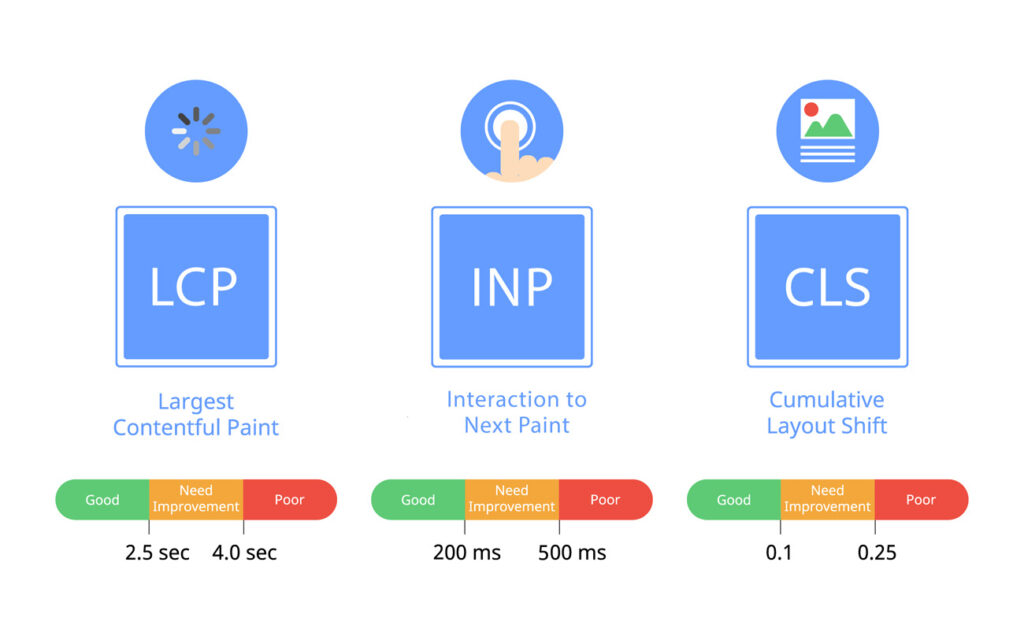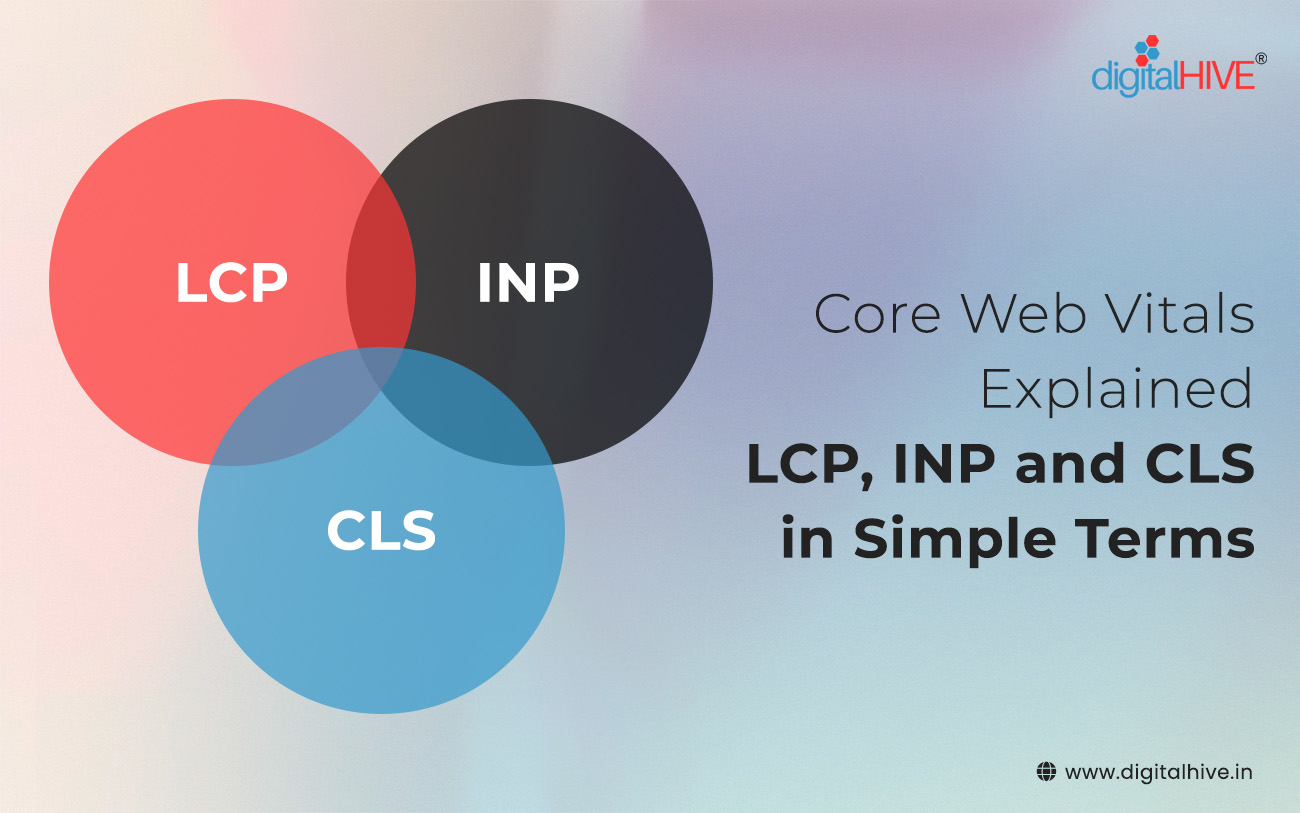If you’ve ever wondered why some websites feel smoother, load faster, and just feel right to browse, the answer lies in Core Web Vitals. These are not just another set of buzzwords thrown around by an SEO agency — they’re a key part of how Google measures user experience. In simple terms, Core Web Vitals help determine whether your site gives visitors a fast, stable, and satisfying experience.
Let’s break down what LCP, INP, and CLS really mean — in plain English — and why they matter for your business and overall digital marketing services strategy.
What Are Core Web Vitals?
Think of Core Web Vitals as Google’s “report card” for your website’s performance. Each metric measures a specific aspect of user experience — loading speed, interactivity, and visual stability.
If your website performs well on these metrics, it not only provides a better experience for your users but also signals to Google that it deserves a higher ranking in search results. That’s why even the best-designed websites need technical optimization — and why a professional digital marketing company pays close attention to these metrics.
The three major Core Web Vitals you need to know are:
- LCP (Largest Contentful Paint) – measures loading performance
- INP (Interaction to Next Paint) – measures interactivity
- CLS (Cumulative Layout Shift) – measures visual stability
Let’s break each one down.
1. LCP (Largest Contentful Paint): How Fast Your Page Loads
LCP measures how long it takes for the largest visible element on your web page to load. This could be an image, video, or a large text block — basically, the main content your visitors are waiting to see.
– Why it matters:
A slow LCP frustrates users. If people have to stare at a blank or half-loaded page, they’ll leave before even seeing your content.
–Ideal benchmark:
To provide a good user experience, your LCP should occur within 2.5 seconds of when the page starts loading.
–How to improve it:
- Optimize and compress images without losing quality.
- Use faster hosting and a Content Delivery Network (CDN).
- Minimize render-blocking scripts and unnecessary plugins.
- Implement lazy loading for offscreen images.
When your website loads fast, users stay longer, bounce less, and convert more — all of which improve the results of your SEO services in Gurgaon or anywhere else.
2. INP (Interaction to Next Paint): How Quickly Your Site Responds
INP is a newer metric that replaces FID (First Input Delay). It measures how responsive your website feels when a user interacts — for example, clicking a button, typing in a form, or selecting a menu.
–Why it matters:
Imagine clicking a “Buy Now” button, and nothing happens for a second or two. That delay can kill conversions instantly. INP ensures your site reacts quickly to every action, giving users a smooth and intuitive experience.
–Ideal benchmark:
A good INP score is below 200 milliseconds — anything slower starts to feel laggy or unresponsive.
–How to improve it:
- Reduce JavaScript execution time.
- Avoid heavy animations that block the main thread.
- Use browser caching to speed up repeat visits.
- Audit and remove unnecessary third-party scripts.
A responsive, fast-interacting site builds trust — and in digital marketing, trust equals conversions.
3. CLS (Cumulative Layout Shift): Keep Your Page Stable
Ever tried to click a button only to have the page suddenly jump, causing you to click something else? That’s CLS — the measurement of how much your layout unexpectedly shifts during loading.
–Why it matters:
A visually unstable page frustrates users and leads to accidental clicks. It’s not just bad design — it’s bad business.
–Ideal benchmark:
Keep your CLS score below 0.1 for a stable, seamless visual experience.
–How to improve it:
- Always set width and height dimensions for images and videos.
- Avoid inserting content above existing text unless necessary.
- Use reserved space for ads, banners, and embeds.
By improving CLS, you ensure your website feels professional and polished — exactly what potential clients expect from a brand backed by a trusted digital marketing company.

Why Core Web Vitals Matter for SEO and Digital Marketing
It’s easy to think of Core Web Vitals as purely technical, but they have a direct impact on your marketing results. Google has made it clear — user experience is now a ranking factor.
When your site loads faster (LCP), responds instantly (INP), and stays stable (CLS), users stay longer and engage more. That tells Google your site deserves higher visibility.
For a digital marketing agency, optimizing Core Web Vitals means:
- Better search rankings and visibility.
- Higher conversion rates and reduced bounce rates.
- Improved brand trust and credibility.
- A measurable boost in ROI across your campaigns.
Good SEO isn’t just about keywords — it’s about experience. Search engines now reward websites that feel good to use.
How to Track and Measure Core Web Vitals
You can easily monitor your Core Web Vitals using free tools like:
- Google PageSpeed Insights – for quick, detailed performance reports.
- Google Search Console – to see real-world data and Core Web Vitals issues.
- Lighthouse or Web.dev – for developer-level insights.
Once you have the data, create a checklist of improvements. Small technical tweaks — like image optimization, script minimization, and improved hosting — can make a massive difference over time.
For businesses partnering with a digital marketing company or an experienced SEO agency, these insights form the foundation of a stronger, faster, and more visible online presence.
Common Mistakes That Hurt Core Web Vitals
Even the best sites can make small mistakes that impact performance:
- Using large, unoptimized media files.
- Overloading pages with scripts and tracking codes.
- Ignoring mobile responsiveness.
- Not testing after each design update.
The key is consistency. Core Web Vitals optimization is not a one-time fix — it’s an ongoing process that aligns with your broader digital marketing services and SEO goals.
Core Web Vitals — LCP, INP, and CLS — are more than just technical terms. They’re the pillars of a high-performing website that delights users and ranks well on search engines.
By focusing on faster load times, smoother interactions, and visual stability, you’re not just improving metrics — you’re building trust, credibility, and better user experiences.
Whether you run a startup or manage an established brand, working with a skilled SEO agency or digital marketing company ensures that your site isn’t just found — it’s remembered.
Because in the end, a great user experience doesn’t just help SEO — it helps your business grow.
